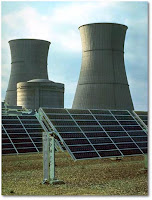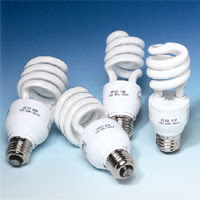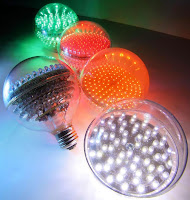Any way the wind blows...

What if... we augmented our dependency on nuclear and fossil fuels with wind power.?
A friend recently suggested that we (Ontario) could switch some of our electrical supply to wind power. Denmark gets about 40% of it's electricity from Wind generators, most in the Black Sea. Currently Ontario has about 85 Mw of wind generation and plans to expand that to 1300Mw. That is equivalent to 2 CANDU 6 reactors.
I am all for green power and the newly installed wind farms in Ontario are a great step forward, but there is one major drawback. The power grid.
Our power grid covers all of North America. The grid has to be balanced, by that I mean power generation should match power demand. There are a few tricks like pumping water uphill and later using the same water to generate power again (hydroelectric). But all in all, the grid must be balanced.
When something goes wrong, like this morning at 6:20am, you get a "bump" the grid was unbalanced for a few seconds and either the bump was caused by... or the bump caused a fire in a transformer substation. End result was a few clocks started flashing "12:00" because we lost power for a few seconds.
Remember the blackout of August 14th 2003 when the Northeast lost power for a few days. An overload in the Ohio grid system kicked 265 power stations off line and put 50 million people in the dark, well it was the afternoon but you get my drift.
What does this have to do with wind power. Wind power is not regular, it unbalances the grid, the more wind power you have the more of a balancing act you have. Here at work one of the profs "in the know" said we could probably handle a 6% to 8% wind generation dip. When the wind falls off and the load needs to be balanced we get our power by increasing reactor or hydro output or by getting electricity from someone else on the grid... our neighbours to the south.
Denmark my get 40% of there power from the wind, but that has to balance someplace when there is no wind. They are fortunate that the winds in the North Sea are pretty predictable.
Local wind power is the way to go, and by local I mean off the grid, single use systems. I will use my cottage as an example.
Walk into Canadian Tire and you can purchase a 400W wind generating system for about $1200 with all the bits and pieces. If my cottage were to be wired (which I can do) so the lights were all on a separate circuit I could use this system to power all my lights, and some other low current draw devices. A battery would store the power when I am not using it and an inverter would convert it back to AC when I need it. The system can also be integrated with a solar panel to give you some juice on sunny days.
You can also dump the battery storage and tie into the grid (your breaker box) with a special inverter... but that will double the price. Thing is, the system payback time is like 20 years, assuming nothing breaks in that time. Personally I plan on building my own generator from a automotive alternator. It doesn't have to be efficient, just cheap.
Payback math
System $1,200 (non grid system)I use the cottage 50 days a year, so lets assume 500 watts/hr I am there (this is way high)
...so 1200Kwh a year, or $54 a year in Hydro savings (.045 per Kwh). I still have to buy hydro because a system like this will not run the air conditioner, fridge, pump, or water heater. None the less...
The system pays for itself in 22 years... maybe.






